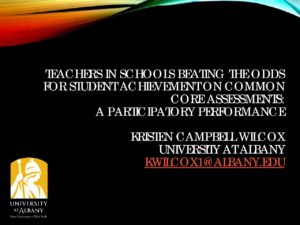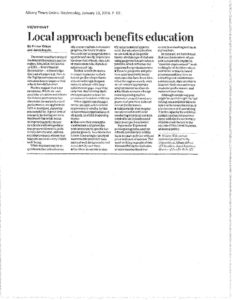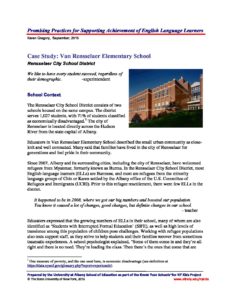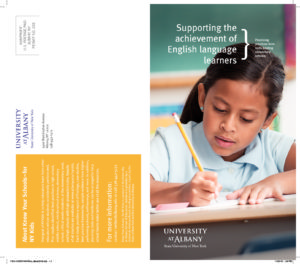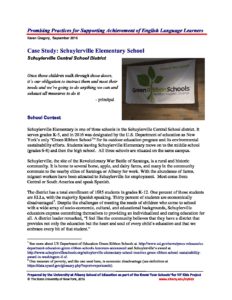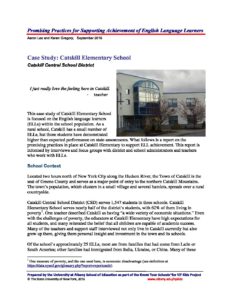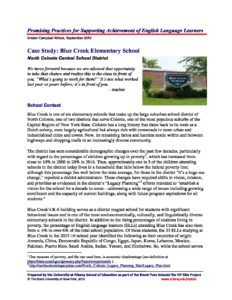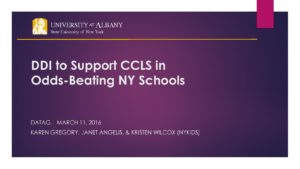Publication Year: 2016
In 2015-16, research teams investigated 6 elementary schools. In comparison to schools serving similar populations at each grade level, these odds-beating schools are ones in which English Language Learners exceeded expected average performance.
This case study is one of a series of studies conducted by Know Your Schools~for NY Kids since 2005. In 2015-16, research teams investigated 6 elementary schools. In comparison to schools serving similar populations at each grade level, these odds-beating schools are ones in which English Language Learners exceeded expected average performance on the 2012-13 and 2013-14 state mathematics and English language arts assessments across multiple grade levels and subjects. Comparisons were for grades three through six. Researchers used site-based interviews of teachers and administrators, as well as analyses of supportive documentation in all schools; in four of the schools student interviews and classroom observations were also conducted.
The presentation describes the association between trust and communication during policy innovation and implementation.
The presentation describes the association between trust and communication during policy innovation and implementation.
The primary purpose for the proposed research was to identify the school practices and policies found in elementary and middle schools whose students exceeded performance expectations on New York State Common Core assessments (as well as those that were used prior to Common Core).
The primary purpose for the proposed research was to identify the school practices and policies found in elementary and middle schools whose students exceeded performance expectations on New York State Common Core assessments (as well as those that were used prior to Common Core).
This research identifies the school practices and policies found in odds-beating elementary and middle schools whose students exceeded performance expectations on New York State assessments aligned with the Common Core State Standards.
This research identifies the school practices and policies found in odds-beating elementary and middle schools whose students exceeded performance expectations on New York State assessments aligned with the Common Core State Standards.
The ELL population in New York State has grown over 20% in the last year, and ELLs now make up over 8% of the New York State student population. Odds-beating schools have systems in place to carefully monitor the progress of their ELLs, connected to systems of interventions for students who need more support.
The ELL population in New York State has grown over 20% in the last year, and ELLs now make up over 8% of the New York State student population. Odds-beating schools have systems in place to carefully monitor the progress of their ELLs, connected to systems of interventions for students who need more support. State English Language Arts and Math assessment data and language proficiency assessment data do not tell the whole story: formative and benchmark assessment are more informative. Systematic reporting and communication/dissemination of multiple measures of student performance allows educators and families to meet the needs of all students.
The English Language Learner (ELL) population in New York State has grown over 20% in the last year, and English Language Learners make up over 8% of the New York State student population. Four elements found to be key to serving ELL population: (1) culture & climate; (2) instruction; (3) leadership and capacity; and (4) communications and collaborations.
The English Language Learner (ELL) population in New York State has grown over 20% in the last year, and English Language Learners make up over 8% of the New York State student population. Four elements found to be key to serving ELL population: (1) culture & climate; (2) instruction; (3) leadership and capacity; and (4) communications and collaborations.
This article discusses the recent reauthorization of the federal Elementary and Secondary Education Action, known as Every Student Succeeds Act (ESSA).
The recent reauthorization of the federal Elementary and Secondary Education Action, known as ESSA – Every Student Succeeds Act – acknowledges that past attempts (e.g. Race to the Top) by government to tell educators how to improve their schools have fallen short. Studies suggest that’s not surprising. While we commend the attention and efforts the federal government has shown for the nation’s school performance, we applaud the shift to localized, statewide accountability. A great deal of research, including our own, has found that what works in improving performance in schools is allowing educators to use evidence to guide locally determined, continuous improvement efforts that take into account every child’s well-being.
The English Language Learner population in New York State has grown over 20%, and English Language Learners make up over 8% of the New York State student population. Four components are important to educating the ELL population including: (1) climate and culture; (2) instruction; (3) leadership & capacity; and (4) communication and collaboration.
The English Language Learner population in New York State has grown over 20%, and English Language Learners make up over 8% of the New York State student population. Four components are important to educating the ELL population including: (1) climate and culture; (2) instruction; (3) leadership & capacity; and (4) communication and collaboration.
In 2015-16, research teams investigated 6 elementary schools. In comparison to schools serving similar populations at each grade level, these odds-beating schools are ones in which English Language Learners exceeded expected average performance.
This case study is one of a series of studies conducted by Know Your Schools~for NY Kids since 2005. In 2015-16, research teams investigated 6 elementary schools. In comparison to schools serving similar populations at each grade level, these odds-beating schools are ones in which English Language Learners exceeded expected average performance on the 2012-13 and 2013-14 state mathematics and English language arts assessments across multiple grade levels and subjects. Comparisons were for grades three through six. Researchers used site-based interviews of teachers and administrators, as well as analyses of supportive documentation in all schools; in four of the schools student interviews and classroom observations were also conducted.
In 2015-16, research teams investigated 6 elementary schools. In comparison to schools serving similar populations at each grade level, these odds-beating schools are ones in which English Language Learners exceeded expected average performance.
This case study is one of a series of studies conducted by Know Your Schools~for NY Kids since 2005. In 2015-16, research teams investigated 6 elementary schools. In comparison to schools serving similar populations at each grade level, these odds-beating schools are ones in which English Language Learners exceeded expected average performance on the 2012-13 and 2013-14 state mathematics and English language arts assessments across multiple grade levels and subjects. Comparisons were for grades three through six. Researchers used site-based interviews of teachers and administrators, as well as analyses of supportive documentation in all schools; in four of the schools student interviews and classroom observations were also conducted.
In 2015-16, research teams investigated 6 elementary schools. In comparison to schools serving similar populations at each grade level, these odds-beating schools are ones in which English Language Learners exceeded expected average performance.
This case study is one of a series of studies conducted by Know Your Schools~for NY Kids since 2005. In 2015-16, research teams investigated 6 elementary schools. In comparison to schools serving similar populations at each grade level, these odds-beating schools are ones in which English Language Learners exceeded expected average performance on the 2012-13 and 2013-14 state mathematics and English language arts assessments across multiple grade levels and subjects. Comparisons were for grades three through six. Researchers used site-based interviews of teachers and administrators, as well as analyses of supportive documentation in all schools; in four of the schools student interviews and classroom observations were also conducted.
In 2015-16, research teams investigated 6 elementary schools. In comparison to schools serving similar populations at each grade level, these odds-beating schools are ones in which English Language Learners exceeded expected average performance.
This case study is one of a series of studies conducted by Know Your Schools~for NY Kids since 2005. In 2015-16, research teams investigated 6 elementary schools. In comparison to schools serving similar populations at each grade level, these odds-beating schools are ones in which English Language Learners exceeded expected average performance on the 2012-13 and 2013-14 state mathematics and English language arts assessments across multiple grade levels and subjects. Comparisons were for grades three through six. Researchers used site-based interviews of teachers and administrators, as well as analyses of supportive documentation in all schools; in four of the schools student interviews and classroom observations were also conducted.
In 2015-16, research teams investigated 6 elementary schools. In comparison to schools serving similar populations at each grade level, these odds-beating schools are ones in which English Language Learners exceeded expected average performance.
This case study is one of a series of studies conducted by Know Your Schools~for NY Kids since 2005. In 2015-16, research teams investigated 6 elementary schools. In comparison to schools serving similar populations at each grade level, these odds-beating schools are ones in which English Language Learners exceeded expected average performance on the 2012-13 and 2013-14 state mathematics and English language arts assessments across multiple grade levels and subjects. Comparisons were for grades three through six. Researchers used site-based interviews of teachers and administrators, as well as analyses of supportive documentation in all schools; in four of the schools student interviews and classroom observations were also conducted.
In 2015-16, research teams investigated 6 elementary schools. In comparison to schools serving similar populations at each grade level, these odds-beating schools are ones in which English Language Learners exceeded expected average performance.
This case study is one of a series of studies conducted by Know Your Schools~for NY Kids since 2005. In 2015-16, research teams investigated 6 elementary schools. In comparison to schools serving similar populations at each grade level, these odds-beating schools are ones in which English Language Learners exceeded expected average performance on the 2012-13 and 2013-14 state mathematics and English language arts assessments across multiple grade levels and subjects. Comparisons were for grades three through six. Researchers used site-based interviews of teachers and administrators, as well as analyses of supportive documentation in all schools; in four of the schools student interviews and classroom observations were also conducted.
In 2015-16, research teams investigated 6 elementary schools. In comparison to schools serving similar populations at each grade level, these odds-beating schools are ones in which English Language Learners exceeded expected average performance.
This case study is one of a series of studies conducted by Know Your Schools~for NY Kids since 2005. In 2015-16, research teams investigated 6 elementary schools. In comparison to schools serving similar populations at each grade level, these odds-beating schools are ones in which English Language Learners exceeded expected average performance on the 2012-13 and 2013-14 state mathematics and English language arts assessments across multiple grade levels and subjects. Comparisons were for grades three through six. Researchers used site-based interviews of teachers and administrators, as well as analyses of supportive documentation in all schools; in four of the schools student interviews and classroom observations were also conducted.
The study identifies the school practices and policies found in elementary and middle schools whose students exceeded performance expectations on the 2012-13 New York State assessments.
The study identifies the school practices and policies found in elementary and middle schools whose students exceeded performance expectations on the 2012-13 New York State assessments. This presentation considers how educators approach data-driven instruction, the types of data used and for what purposes, and practices or processes to support data-driven instruction.



